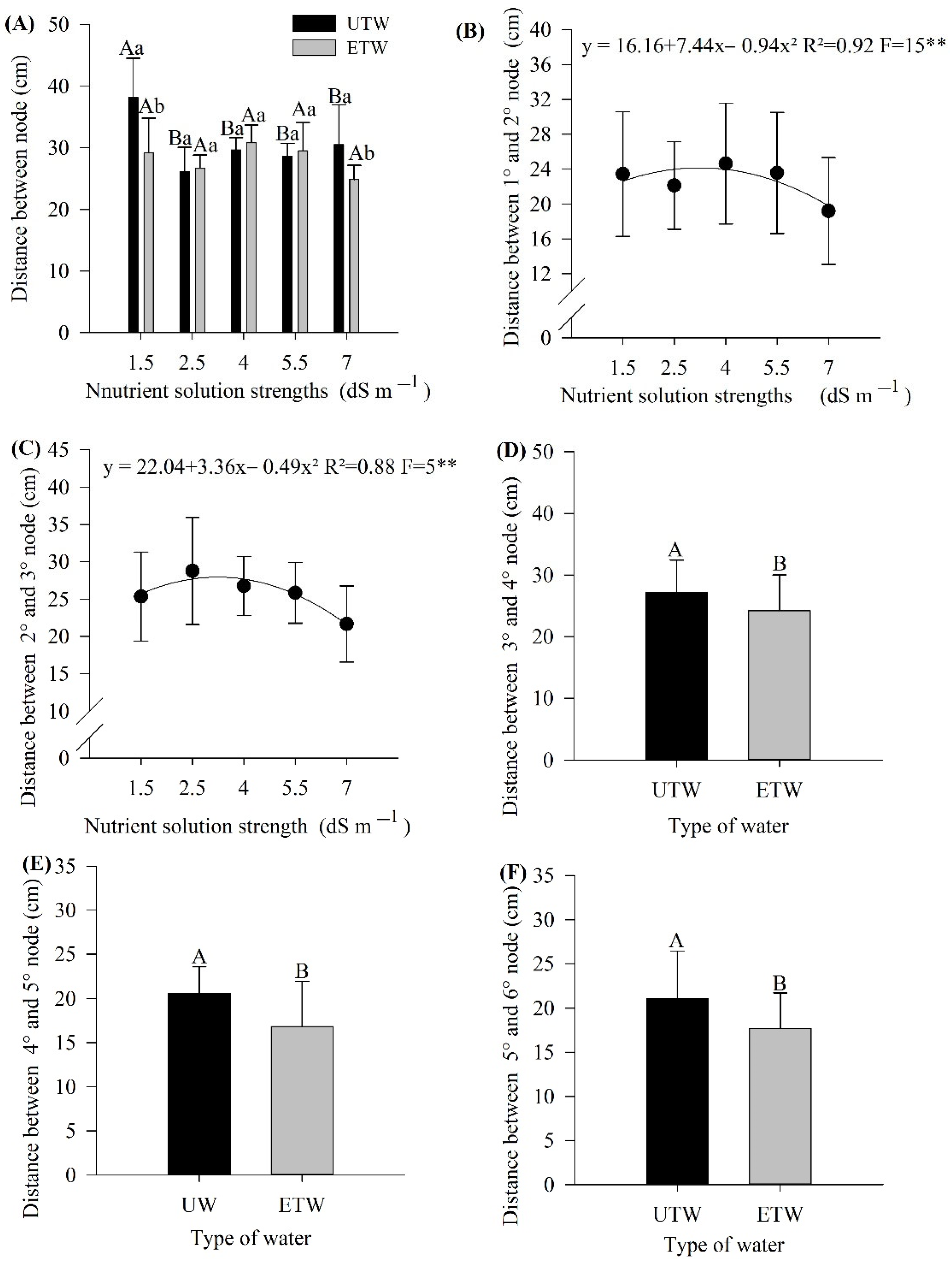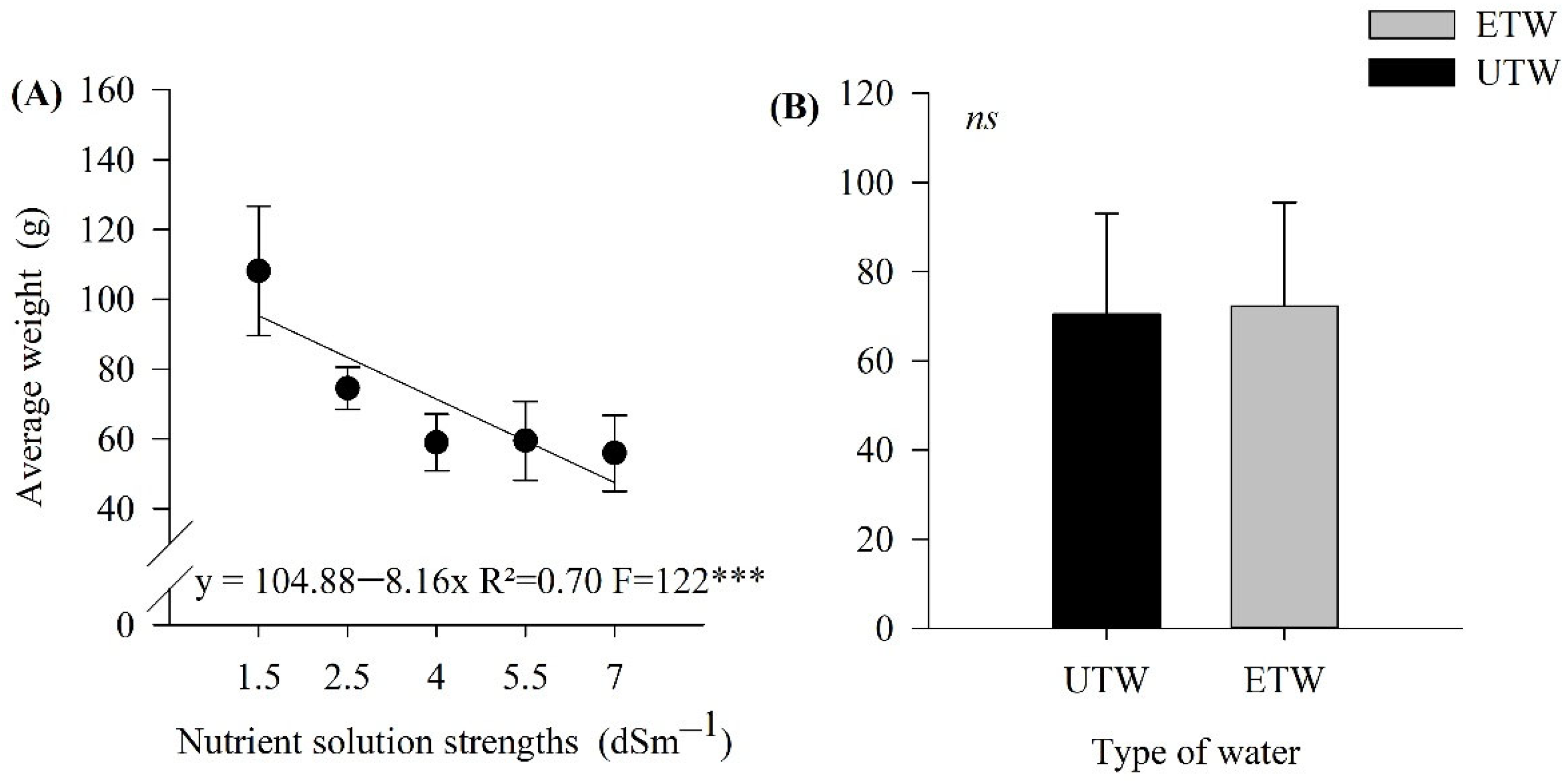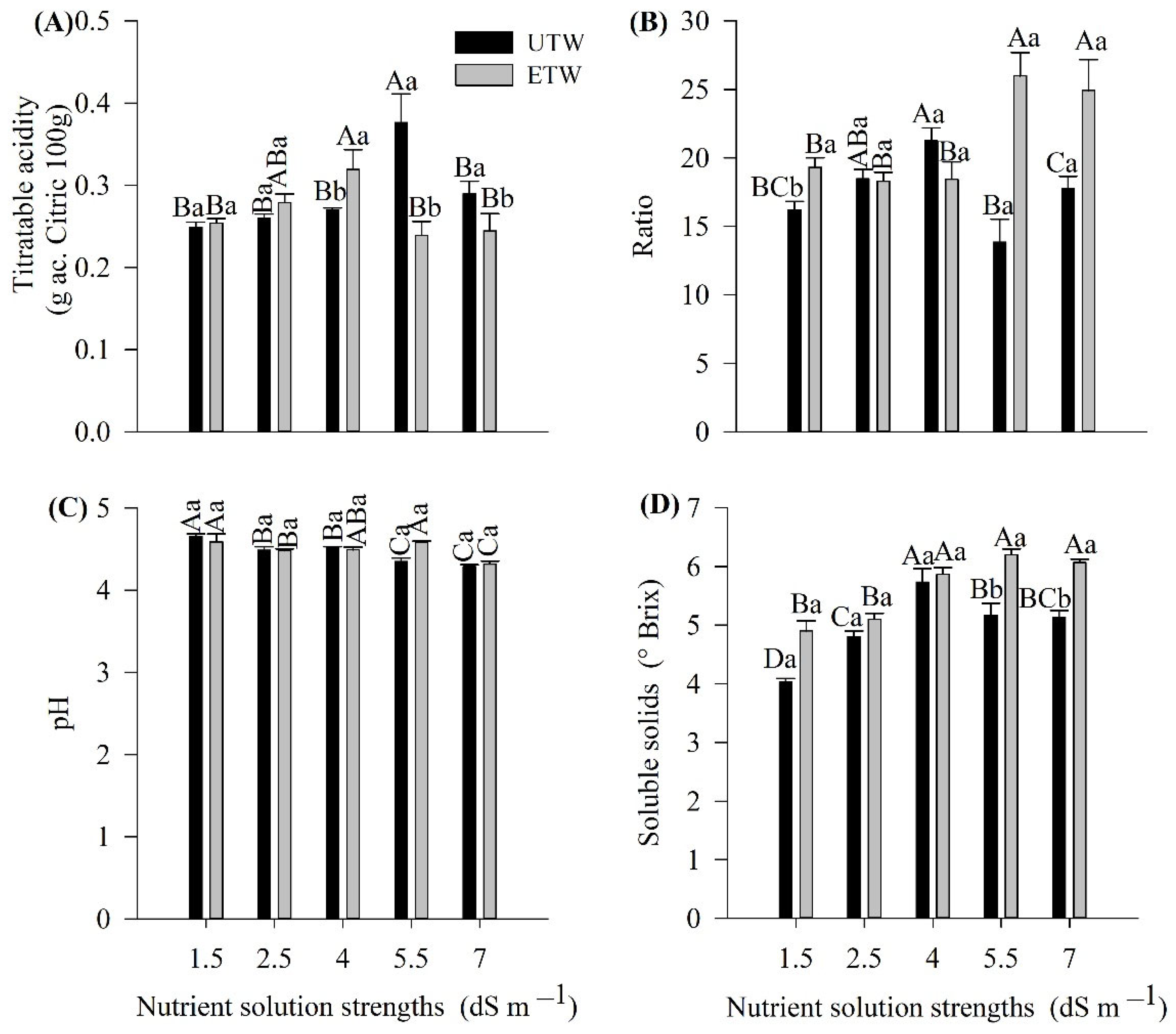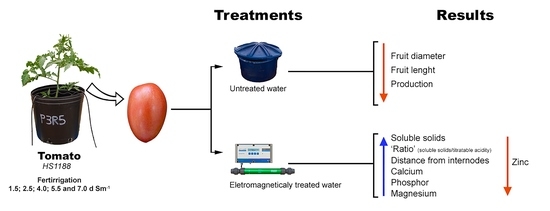Productive and Physico-Chemical Parameters of Tomato Fruits Submitted to Fertigation Doses with Water Treated with Very Low-Frequency Electromagnetic Resonance Fields
Abstract
1. Introduction
2. Materials and Methods
2.1. Experimental Area
2.2. Treatments
2.3. Planting and Plant Management
2.4. Electromagnetic Treatment of Water
2.5. Irrigation Management
2.6. Physico-Chemical Analysis of the Fruits
2.6.1. Soluble Solids (SS)
2.6.2. Titratable Acidity (TA)
2.6.3. Ratio SS/TA
2.6.4. pH
2.7. Distance between Internodes
2.8. Branch Weight
2.9. Average Length and Fruit Diameter
2.10. Nutritional Analysis
2.11. Statistical Analysis
3. Results
Biometric Analysis
4. Discussion
5. Conclusions
Author Contributions
Funding
Institutional Review Board Statement
Informed Consent Statement
Data Availability Statement
Conflicts of Interest
References
- Usanmaz, S.; Atti, M.K. Animal manures and some chemicals as soil supplement to improve growth, yield and fruit quality of tomato. Pak. J. Bot. 2020, 52, 1289–1298. [Google Scholar] [CrossRef]
- Helvaci, M. Determination of Tomato Leafminer (Tuta absoluta) Population in Open Field and Greenhouse Tomato Growing Areas on Turkish Republic of Northern Cyprus. Int. J. Agric. For. Life Sci. 2020, 4, 107–110. [Google Scholar]
- Monteiro, C.S.; Balbi, M.E.; Miguel, O.G.; Maria, S.; Haracemiv, C. Qualidade Nutricional E Antioxidante Do Tomate “Tipo Italiano”. Alim. Nutr. 2008, 19, 25–31. [Google Scholar]
- Gelder, A.; Dieleman, J.A.; Bot, G.P.A.; Marcelis, L.F.M. An Overview of Climate and Crop Yield in Closed Greenhouses. J. Hortic. Sci. Biotechnol. 2012, 87, 193–202. [Google Scholar] [CrossRef]
- Wang, H.; Li, J.; Cheng, M.; Zhang, F.; Wang, X.; Fan, J.; Wu, L.; Fang, D.; Zou, H.; Xiang, Y. Optimal Drip Fertigation Management Improves Yield, Quality, Water and Nitrogen Use Efficiency of Greenhouse Cucumber. Sci. Hortic. 2019, 243, 357–366. [Google Scholar] [CrossRef]
- Ahamed, A.A.; Abdalla, A.M.S. Effect of Salinity and NPK Fertilizer on the Total Soluble Solids (TSS) and N, P and K in Tomato Plants (Lycoperisicon esculentum L.). Int. J. Acad. Multidiscip. Res. 2019, 3, 39–42. [Google Scholar]
- Hanin, M.; Ebel, C.; Ngom, M.; Laplaze, L.; Masmoudi, K. New Insights on Plant Salt Tolerance Mechanisms and Their Potential Use for Breeding. Front. Plant Sci. 2016, 7, 1787. [Google Scholar] [CrossRef]
- Kaman, H.; Kurunç, A.; Demir, H.; Tezcan, A.; Sayici, A.; Can, M.; Gökçen, U. Salinity Change in Different Soil Layers of Tomato Irrigated with Salty Water. Int. J. Plant Soil Sci. 2017, 19, 1–6. [Google Scholar] [CrossRef]
- Putti, F.F.; Gabriel Filho, L.R.A.; Klar, A.E.; da Silva Junior, J.F.; Cremasco, C.P.; Ludwig, R. Response of Lettuce Crop to Magnetically Treated Irrigation Water and Different Irrigation Depths. Afr. J. Agric. Res. 2015, 10, 2300–2308. [Google Scholar] [CrossRef]
- Selim, D.A.F.H.; Nassar, R.M.A.; Boghdady, M.S.; Bonfill, M. Physiological and Anatomical Studies of Two Wheat Cultivars Irrigated with Magnetic Water under Drought Stress Conditions. Plant Physiol. Biochem. 2019, 135, 480–488. [Google Scholar] [CrossRef]
- Surendran, U.; Sandeep, O.; Joseph, E.J. The Impacts of Magnetic Treatment of Irrigation Water on Plant, Water and Soil Characteristics. Agric. Water Manag. 2016, 178, 21–29. [Google Scholar] [CrossRef]
- Zlotopolski, V. The Impact of Magnetic Water Treatment on Salt Distribution in a Large Unsaturated Soil Column. Int. Soil Water Conserv. Res. 2017, 5, 253–257. [Google Scholar] [CrossRef]
- Yamabhai, M.; Chumseng, S.; Yoohat, K.; Srila, W. Diverse Biological Effects of Electromagnetic-Treated Water. Homeopathy 2014, 103, 186–192. [Google Scholar] [CrossRef] [PubMed]
- Khoshravesh, M.; Mostafazadeh-Fard, B.; Mousavi, S.F.; Kiani, A.R. Effects of Magnetized Water on the Distribution Pattern of Soil Water with Respect to Time in Trickle Irrigation. Soil Use Manag. 2011, 27, 515–522. [Google Scholar] [CrossRef]
- Mghaiouini, R.; Salah, M.; Monkade, M.; El Bouari, A. A New Knowledge of Water Magnetism Phenomenon. Arab. J. Sci. Eng. 2021, 47, 1129–1136. [Google Scholar] [CrossRef]
- Putti, F.F.; Vacaro de Souza, A.; Zanetti, W.A.L.; Bueno Nogueira, B.; Domingues Neto, F.J.; de Queiroz Barcelos, J.P.; de Lucca Sartori, D. Growth and Absorption Curve of Nutrients in Tomato Crop ‘BRS Imigrante’ Cultivar Grown in Coconut Fiber. J. Plant Nutr. 2022, 1–12. [Google Scholar] [CrossRef]
- Moreira de Carvalho, D.B.; de Souza, A.V.; Domingues Neto, F.J.; Iglesias, L.; Nogueira, B.B.; Zanetti, W.A.; Gabriel Filho, L.R.A.; Putti, F.F. Growth Models and Nutriente Uptake Curve of Tomato BRS 1509 Subjected to Irrigation Pulses. J. Plant Nutr. 2020, 43, 1999–2012. [Google Scholar] [CrossRef]
- de Souza, A.V.; de Mello, J.M.; da Silva Favaro, V.F.; dos Santos, T.G.F.; dos Santos, G.P.; de Lucca Sartori, D.; Ferrari Putti, F. Metabolism of Bioactive Compounds and Antioxidant Activity in Bananas during Ripening. J. Food Process. Preserv. 2021, 45, e15959. [Google Scholar] [CrossRef]
- de Souza, A.V.; de Mello, J.M.; da Silva Favaro, V.F.; da Silva, V.F.; dos Santos, T.G.F.; de Lucca Sartori, D.; Putti, F.F. Antioxidant Activity, Bioactive Compounds, and Agro-Industrial Quality: Correlations between Parameters in Fresh and Processed Tomatoes. J. Food Process. Preserv. 2021, 45, e15696. [Google Scholar] [CrossRef]
- Banzato, D.A.; Kronka, S.N. Experimentação Agrícola, 4th ed.; FUNEP: Jaboticabal, Brazil, 2006. [Google Scholar]
- de Oliveira, C.S.; Mascarenhas Maciel, G.; Carolina Silva Siquieroli, A.; Araújo Gomes, D.; Mendes Diniz, N.; Magno Queiroz Luz, J.; Yoshio Yada, R. Artificial Neural Networks and Genetic Dissimilarity among Saladette Type Dwarf Tomato Plant Populations. Food Chem. Mol. Sci. 2021, 3, 100056. [Google Scholar] [CrossRef]
- Mueller, S.; Wamser, A.F. Combinação Da Altura de Desponte e Do Espaçamento Entre Plantas de Tomate. Hortic. Bras. 2009, 27, 64–69. [Google Scholar] [CrossRef]
- Maciel, G.M.; Finzi, R.R.; Carvalho, F.J.; Marquez, G.R.; Clemente, A.A. Agronomic Performance and Genetic Dissimilarity among Cherry Tomato Genotypes. Hortic. Bras. 2018, 36, 167–172. [Google Scholar] [CrossRef]
- Ripoll, J.; Urban, L.; Brunel, B.; Bertin, N. Water Deficit Effects on Tomato Quality Depend on Fruit Developmental Stage and Genotype. J. Plant Physiol. 2016, 190, 26–35. [Google Scholar] [CrossRef] [PubMed]
- Villas Boas, R.L.; Kano, C.; Lima, C.P.; Nanetti, F.A.; Fernandes, D.M. Efeito de Doses de Nitrogênio Aplicado de Forma Convencional e Através Da Fertirrigação Na Cultura Do Pimentão. Hortic. Bras. 2000, 18, 801–802. [Google Scholar]
- Rai, A.K.; Vikram, A.; Pal, S. Genetic Characterization of Tomato Germplasm for Yield and Quality Traits through Principal Component Analysis. Res. J. Agric. Sci. 2017, 8, 1171–1174. [Google Scholar]
- Yamamoto, K.; Guo, W.; Ninomiya, S. Node Detection and Internode Length Estimation of Tomato Seedlings Based on Image Analysis and Machine Learning. Sensors 2016, 16, 1044. [Google Scholar] [CrossRef]
- Kalaitzoglou, P.; van Ieperen, W.; Harbinson, J.; van der Meer, M.; Martinakos, S.; Weerheim, K.; Nicole, C.C.S.; Marcelis, L.F.M. Effects of Continuous or End-of-Day Far-Red Light on Tomato Plant Growth, Morphology, Light Absorption, and Fruit Production. Front. Plant Sci. 2019, 10, 322. [Google Scholar] [CrossRef]
- Diouf, I.A.; Derivot, L.; Bitton, F.; Pascual, L.; Causse, M. Water Deficit and Salinity Stress Reveal Many Specific QTL for Plant Growth and Fruit Quality Traits in Tomato. Front. Plant Sci. 2018, 9, 279. [Google Scholar] [CrossRef]
- Pandey, P.; Irulappan, V.; Bagavathiannan, M.V.; Senthil-Kumar, M. Impact of Combined Abiotic and Biotic Stresses on Plant Growth and Avenues for Crop Improvement by Exploiting Physio-Morphological Traits. Front. Plant Sci. 2017, 8, 537. [Google Scholar] [CrossRef]
- Medeiros, P.R.F.; Duarte, S.N.; Uyeda, C.A.; Silva, Ê.F.F.; Medeiros, J.F. De Tolerância da Cultura do Tomate à Salinidade do Solo em Ambiente Protegido. Rev. Bras. Eng. Agríc. E Ambient. 2012, 16, 51–55. [Google Scholar] [CrossRef][Green Version]
- Yusuf, K.O.; Sakariyah, S.A.; Baiyeri, M.R. Influence of Magnetized Water and Seed on Yield and Uptake of Heavy Metals of Tomato. Not. Sci. Biol. 2019, 11, 122–129. [Google Scholar] [CrossRef][Green Version]
- Hachicha, M.; Kahlaoui, B.; Khamassi, N.; Misle, E.; Jouzdan, O. Effect of Electromagnetic Treatment of Saline Water on Soil and Crops. J. Saudi Soc. Agric. Sci. 2018, 17, 154–162. [Google Scholar] [CrossRef]
- Anthon, G.E.; Barrett, D.M. Pectin Methylesterase Activity and Other Factors Affecting PH and Titratable Acidity in Processing Tomatoes. Food Chem. 2012, 132, 915–920. [Google Scholar] [CrossRef]
- Alcántar, G.C.; Villarreal, M.R.; Aguilar, A.S. Tomato growth (Lycopersicon esculentum mill), and nutrient utilization in response to varying fertigation programs. In International Symposium on Growing Media and Hydroponics; International Society for Horticultural Science: Leuven, Belgium, 1999; pp. 385–392. [Google Scholar] [CrossRef]
- De Pascale, S.; Maggio, A.; Fogliano, V.; Ambrosino, P.; Ritieni, A. Irrigation with Saline Water Improves Carotenoids Content and Antioxidant Activity of Tomato. J. Hortic. Sci. Biotechnol. 2001, 76, 447–453. [Google Scholar] [CrossRef]
- Cramer, M.D.; Oberholzer, J.A.; Combrink, N.J.J. The Effect of Supplementation of Root Zone Dissolved Inorganic Carbon on Fruit Yield and Quality of Tomatoes (Cv ’Daniella’) Grown with Salinity. Sci. Hortic. 2001, 89, 269–289. [Google Scholar] [CrossRef]
- de Rebouças Neto, M.O.; de Azevedo, B.M.; de Viana, T.V.A.; de Mesquita, J.B.R.; de Carvalho, M.A.R.; de Carvalho, L.C.C. Potassium Fertilization via Fertigation and Conventional Application on Quality of Tomato Fruits. Rev. Bras. Eng. Agric. E Ambient. 2016, 20, 913–917. [Google Scholar] [CrossRef][Green Version]
- Schwarz, D.; Öztekin, G.B.; Tüzel, Y.; Brückner, B.; Krumbein, A. Rootstocks Can Enhance Tomato Growth and Quality Characteristics at Low Potassium Supply. Sci. Hortic. 2013, 149, 70–79. [Google Scholar] [CrossRef]
- Liu, K.; Zhang, T.Q.; Tan, C.S.; Astatkie, T. Responses of Fruit Yield and Quality of Processing Tomato to Drip-Irrigation and Fertilizers Phosphorus and Potassium. Agron. J. 2011, 103, 1339–1345. [Google Scholar] [CrossRef]
- Asri, F.O.; Demirtas, E.I.; Ari, N. Changes in Fruit Yield, Quality and Nutrient Concentrations in Response to Soil Humic Acid Applications in Processing Tomato. Bulg. J. Agric. Sci. 2015, 21, 585–591. [Google Scholar]
- Melo, R.A.C.; Jorge, M.H.A.; Bortolin, A.; Boiteux, L.S.; Ribeiro, C.; Marconcini, J.M. Growth of Tomato Seedlings in Substrates Containing a Nanocomposite Hydrogel with Calcium Montmorillonite (NC-MMt). Hortic. Bras. 2019, 37, 199–203. [Google Scholar] [CrossRef]
- Sakamoto, Y.; Watanabe, S.; Nakashima, T.; Okano, K. Effects of Salinity at Two Ripening Stages on the Fruit Quality of Single-Truss Tomato Grown in Hydroponics. J. Hortic. Sci. Biotechnol. 1999, 74, 690–693. [Google Scholar] [CrossRef]
- Munns, R. Salinity, Growth and Phytohormones. In Salinity: Environment-Plants-Molecules; Lauchli, A., Luttge, U., Eds.; Kluwer Academic Publishers: New York, NY, USA, 2012; Volume 91, pp. 271–290. ISBN 9788578110796. [Google Scholar]
- Kader, A.; Stevens, M.A. Composition and Flavor Quality of Fresh Market Tomatoes as Influenced by Some Postharvest Handling Procedures. J. Am. Soc. Hortic. Sci. 1978, 103, 6–13. [Google Scholar]
- Elloumi, N.; Mohamed, Z.; Fakhri, N.; Mehdaoui, H.Y.; Chaari, L.; ben Abdallah, F.; Kallel, M. Effects of Magnetic Saline Water Application for Improving Physiological Parameters of Tomato (Solanum lycopersicum) Seedlings. Ethiop. J. Environ. Stud. Manag. 2018, 11, 131–143. [Google Scholar]
- Fakhri, N.; Mehdaoui, H.Y.; Elloumi, N.; Kallel, M. Magnetic Treatment Effects on Salt Water and Tomato Plants Growth. In Recent Advances in Environmental Science from the Euro-Mediterranean and Surrounding Regions. EMCEI 2017; Kallel, A., Ksibi, M., Ben Dhia, H., Khélifi, N., Eds.; Advances in Science, Technology & Innovation; Springer: Cham, Switzerland, 2018. [Google Scholar] [CrossRef]
- El-Zawily, A.E.-S.; Meleha, M.; El-Sawy, M.; El-Attar, E.H.; Bayoumi, Y.; Alshaal, T. Application of Magnetic Field Improves Growth, Yield and Fruit Quality of Tomato Irrigated Alternatively by Fresh and Agricultural Drainage Water. Ecotoxicol. Environ. Saf. 2019, 181, 248–254. [Google Scholar] [CrossRef] [PubMed]
- Saure, M.C. Blossom-End Rot of Tomato (Lycopersicon esculentum Mill.)—A Calcium- or a Stress-Related Disorder? Sci. Hortic. 2001, 90, 193–208. [Google Scholar] [CrossRef]
- Saure, M.C. Why Calcium Deficiency Is Not the Cause of Blossom-End Rot in Tomato and Pepper Fruit—A Reappraisal. Sci. Hortic. 2014, 174, 151–154. [Google Scholar] [CrossRef]





| Plant Development Phase | |||||
| Nutrients (g L−1) | 1.5 | 2.5 | 4.0 | 5.5 | 7.0 |
| dSm−1 | |||||
| Calcium nitrate | 0.6300 | 1.0500 | 1.6800 | 2.3100 | 2.9400 |
| Urea | 0.0600 | 0.1000 | 0.1600 | 0.2200 | 0.2800 |
| Potassium nitrate | 0.2400 | 0.4000 | 0.6400 | 0.8800 | 1.1200 |
| Potassium chloride | 0.1800 | 0.3000 | 0.4800 | 0.6600 | 0.8400 |
| Potassium sulfate | 0.0600 | 0.1000 | 0.1600 | 0.2200 | 0.2800 |
| Magnesium nitrate | 0.1200 | 0.2000 | 0.3200 | 0.4400 | 0.5600 |
| Magnesium sulfate | 0.0600 | 0.1000 | 0.1600 | 0.2200 | 0.2800 |
| MKP | 0.1680 | 0.2800 | 0.4480 | 0.6160 | 0.7840 |
| Zinc sulfate | 0.0018 | 0.0030 | 0.0048 | 0.0066 | 0.0084 |
| Boric acid | 0.0048 | 0.0080 | 0.0128 | 0.0176 | 0.0224 |
| Chelated iron | 0.0120 | 0.0200 | 0.0320 | 0.0440 | 0.0560 |
| Production Phase | |||||
| Nutrients (g L−1) | 1.5 | 2.5 | 4.0 | 5.5 | 7.0 |
| dSm−1 | |||||
| Calcium nitrate | 0.6684 | 1.1140 | 1.7824 | 2.4508 | 3.1192 |
| Urea | 0.0660 | 0.1100 | 0.1760 | 0.2420 | 0.3080 |
| Potassium nitrate | 0.2580 | 0.4300 | 0.6880 | 0.9460 | 1.2040 |
| Potassium chloride | 0.0180 | 0.0300 | 0.0480 | 0.0660 | 0.0840 |
| Potassium sulfate | 0.0660 | 0.1100 | 0.1760 | 0.2420 | 0.3080 |
| Magnesium nitrate | 0.1320 | 0.2200 | 0.3520 | 0.4840 | 0.6160 |
| Magnesium sulfate | 0.0660 | 0.1100 | 0.1760 | 0.2420 | 0.3080 |
| MKP | 0.1800 | 0.3000 | 0.4800 | 0.6600 | 0.8400 |
| Zinc sulfate | 0.0020 | 0.0033 | 0.0053 | 0.0073 | 0.0092 |
| Boric acid | 0.0054 | 0.0090 | 0.0144 | 0.0198 | 0.0252 |
| Chelated iron | 0.0132 | 0.0220 | 0.0352 | 0.0484 | 0.0616 |
| Distance between the Nodes | ||||||
| Factor | Distance between Node | Distance between 1st and 2nd Node | Distance between 2nd and 3rd Node | Distance between 3rd and 4th Node | Distance between 4th and 5th Node | Distance between 5th and 6th Node |
| N.S.S. | 0.0020 | <0.0001 | <0.0001 | 0.6380 | 0.2350 | 0.0874 |
| T.W. | <0.0001 | 0.5320 | 0.0548 | <0.0001 | <0.0001 | <0.0001 |
| T.W. X N.S.S. | <0.0001 | 0.2310 | 0.4120 | 0.0985 | 0.4680 | 0.1230 |
| C.V. (%) | 8.98 | 10.87 | 18.95 | 12.58 | 7.58 | 15.85 |
| Biometric rating of the fruits | ||||||
| Factor | Branch Weight | Average fruit diameter | Number of fruits | Diameter of fruits | Weight non-commercial fruits | Average weight |
| N.S.S. | <0.0001 | <0.0001 | <0.0001 | <0.0001 | <0.0001 | <0.0001 |
| T.W. | <0.0001 | <0.0001 | <0.0001 | <0.0001 | <0.0001 | 0.2360 |
| T.W. X N.S.S. | <0.0001 | <0.0001 | 0.0845 | 0.5963 | 0.2580 | 0.0850 |
| C.V. (%) | 16.78 | 15.96 | 18.95 | 11.36 | 18.63 | 9.85 |
| Chemical rating | ||||||
| Factor | Titratable Acidity | SS | pH | Ratio | ||
| N.S.S. | 0.0002 | <0.0001 | <0.0001 | 0.0014 | ||
| T.W. | 0.0033 | <0.0001 | 0.0328 | <0.0001 | ||
| T.W. X N.S.S. | <0.0001 | <0.0001 | <0.0001 | <0.0001 | ||
| C.V. (%) | 6.30 | 2.69 | 8.99 | 6.68 | ||
| Nutritional rating of the fruits | ||||||
| Factor | N | P | K | Ca | Mg | S |
| N.S.S. | 0.0002 | 0.0049 | 0.0003 | <0.0001 | <0.0001 | 0.0024 |
| T.W. | 0.1490 | 0.0427 | 0.4890 | <0.0001 | 0.0037 | 0.0008 |
| T.W. X N.S.S. | 0.1020 | 0.0030 | 0.0560 | <0.0001 | <0.0001 | 0.8750 |
| C.V. (%) | 9.87 | 17.58 | 7.85 | 4.39 | 15.65 | 8.42 |
| Chemical rating | ||||||
| Factor | B | Cu | Fe | Mn | Zn | |
| N.S.S. | 0.0554 | <0.0001 | <0.0001 | <0.0001 | <0.0001 | |
| T.W. | <0.0001 | 0.0370 | 0.0770 | 0.0770 | <0.0001 | |
| T.W. X N.S.S. | 0.0060 | <0.0001 | <0.0001 | 0.2880 | <0.0001 | |
| C.V. (%) | 10.06 | 8.28 | 8.03 | 9.90 | 9.43 | |
| Treatments | N | P | K | Ca | Mg | S | B | Mn | Fe | Cu | Zn | |
| g kg−1 | mg kg−1 | |||||||||||
| Type of water | ETW | 21.56 a | 5.19 a | 32.60 a | 2.17 a | 1.48 a | 2.45 a | 19.52 a | 20.33 a | 57.26 a | 14.70 a | 42.70 b |
| UTW | 20.42 a | 4.51 b | 31.95 a | 1.98 b | 1.22 b | 2.17 b | 14.38 b | 19.00 b | 54.20 a | 15.30 a | 49.00 a | |
| 1.5 dSm−1 | ETW | 18.66 | 4.21 Ba | 33.75 | 2.85 Aa | 1.35 Ba | 2.34 | 17.49 Ba | 30.00 Aa | 66.00 Aa | 13.50 Ba | 54.00 Aa |
| UTW | 18.73 | 3.97 Ba | 30.45 | 1.60 Bb | 1.20 Aba | 1.96 | 14.01 Ab | 19.50 Abb | 50.50 Bb | 14.00 Ba | 38.50 CDb | |
| 2.5 dSm−1 | ETW | 16.87 | 7.30 Aa | 31.70 | 2.12 Ba | 2.70 Aa | 2.57 | 23.86 Aa | 21.17 Ba | 31.95 Cb | 21.17 Ba | 33.00 Bb |
| UTW | 18.41 | 3.92 Bba | 29.65 | 2.15 Aa | 1.10 Bb | 2.28 | 13.85 Ab | 14.00 Cb | 53.50 Ba | 15.50 Ab | 78.50 Aa | |
| 4.0 dSm−1 | ETW | 21.98 | 5.12 Ba | 30.03 | 2.10 Ba | 1.05 Ba | 2.56 | 19.84 Aba | 15.00 Bb | 65.00 Aa | 13.00 Ba | 40.50 Ba |
| UTW | 21.28 | 4.80 Aba | 31.75 | 2.20 Aa | 1.10 Ba | 2.40 | 13.36 Ab | 22.50 Aa | 48.50 Bb | 14.50 Ba | 46.00 Bca | |
| 5.5 dSm−1 | ETW | 24.29 | 4.99 Ba | 35.70 | 1.95 BCb | 1.15 Bb | 2.58 | 18.87 Ba | 15.50 Cb | 76.00 Aa | 12.50 Bb | 43.00 Bb |
| UTW | 22.96 | 6.31 Aa | 39.90 | 2.15 Aa | 1.70 Aa | 2.33 | 15.38 Ab | 23.00 Aa | 66.00 Ab | 20.50 Aba | 51.50 Ba | |
| 7.0 dSm−1 | ETW | 25.99 | 4.35 Ba | 31.83 | 1.87 Ca | 1.13 Ba | 2.22 | 17.54 Ba | 20.00 Ca | 47.33 Ba | 13.33 Ba | 43.00 Ba |
| UTW | 20.72 | 3.56 Ba | 28.00 | 1.80 Bb | 1.00 Ba | 1.87 | 15.30 Ab | 16.00 Bca | 52.50 Ba | 12.00 Ba | 30.50 Db | |
| C.V. (%) | 9.87 | 17.58 | 7.85 | 4.39 | 15.65 | 8.42 | 10.06 | 9.90 | 8.03 | 9.90 | 9.43 | |
| T.W. | 2.27 ns | 5.40 * | 0.50 | 35.05 ** | 11.10 ** | 16.07 ** | 68.03 ** | 5.02 * | 5.02 * | 1.22 ns | 15.91 * | |
| N.S.S. | 10.30 ** | 4.76 * | 9.48 * | 16.31 ** | 15.82 ** | 6.29 ** | 2.83 ns | 19.19 ** | 19.19 ** | 14.90 ** | 15.21 * | |
| T.W. X N.S.S. | 2.27 ns | 5.99 * | 0.05 ns | 63.97 ** | 21.69 ** | 0.30 ns | 5.08 ** | 39.71 ** | 39.71 ** | 16.75 ** | 47.51 ** | |
Publisher’s Note: MDPI stays neutral with regard to jurisdictional claims in published maps and institutional affiliations. |
© 2022 by the authors. Licensee MDPI, Basel, Switzerland. This article is an open access article distributed under the terms and conditions of the Creative Commons Attribution (CC BY) license (https://creativecommons.org/licenses/by/4.0/).
Share and Cite
Putti, F.F.; Nogueira, B.B.; Vacaro de Souza, A.; Festozo Vicente, E.; Zanetti, W.A.L.; de Lucca Sartori, D.; Pigatto de Queiroz Barcelos, J. Productive and Physico-Chemical Parameters of Tomato Fruits Submitted to Fertigation Doses with Water Treated with Very Low-Frequency Electromagnetic Resonance Fields. Plants 2022, 11, 1587. https://doi.org/10.3390/plants11121587
Putti FF, Nogueira BB, Vacaro de Souza A, Festozo Vicente E, Zanetti WAL, de Lucca Sartori D, Pigatto de Queiroz Barcelos J. Productive and Physico-Chemical Parameters of Tomato Fruits Submitted to Fertigation Doses with Water Treated with Very Low-Frequency Electromagnetic Resonance Fields. Plants. 2022; 11(12):1587. https://doi.org/10.3390/plants11121587
Chicago/Turabian StylePutti, Fernando Ferrari, Bianca Bueno Nogueira, Angela Vacaro de Souza, Eduardo Festozo Vicente, Willian Aparecido Leoti Zanetti, Diogo de Lucca Sartori, and Jéssica Pigatto de Queiroz Barcelos. 2022. "Productive and Physico-Chemical Parameters of Tomato Fruits Submitted to Fertigation Doses with Water Treated with Very Low-Frequency Electromagnetic Resonance Fields" Plants 11, no. 12: 1587. https://doi.org/10.3390/plants11121587
APA StylePutti, F. F., Nogueira, B. B., Vacaro de Souza, A., Festozo Vicente, E., Zanetti, W. A. L., de Lucca Sartori, D., & Pigatto de Queiroz Barcelos, J. (2022). Productive and Physico-Chemical Parameters of Tomato Fruits Submitted to Fertigation Doses with Water Treated with Very Low-Frequency Electromagnetic Resonance Fields. Plants, 11(12), 1587. https://doi.org/10.3390/plants11121587









